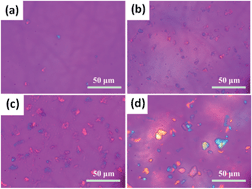Influences of polyhedral oligomeric silsesquioxanes (POSSs) containing different functional groups on crystallization and melting behaviors of POSS/polydimethylsiloxane rubber composites
Abstract
In this article, three kinds of polyhedral oligomeric silsesquioxanes (POSSs)—octamethylsilsesquioxane (OMS), octaphenylsilsesquioxane (OPS) and heptaphenylhydrogensilsesquioxane (H-POSS)—were successfully synthesized. Then, POSSs were incorporated into polydimethylsiloxane (PDMS) rubber through solution blending followed by open two-roll mill blending with curing agent. Finally, the blends were cured with a plate vulcanizing press and the effects of POSSs on crystallization and melting behaviors of PDMS were investigated. DSC tests indicated that crystallinity (Xc) of the OMS/PDMS composite was lowered, while Xc and the melting temperature (Tm) of the OPS/PDMS composite could be significantly enhanced when 20 wt% OPS was incorporated. OPS was proved to play a role as a nucleating agent in the crystallization of PDMS, but its nucleation mechanism was different from H-POSS which was previously studied by us. The crystals of OPS were flake-like with huge surfaces which provide templates for PDMS crystals to grow. However, due to the grafting of H-POSS onto PDMS chains, H-POSS played a role as physical crosslinking points to reduce the mobility of the PDMS chain segments.


 Please wait while we load your content...
Please wait while we load your content...